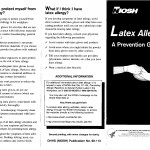For Non-Biological Sharps
Please put an orange chemical waste sticker over the biohazard label on your red sharps container. Write on the label Non-Biological sharps, then fill out the waste label completely (Name, Dept., Date, and Phone number on the bottom). Then put the sharps disposal container in the waste collection area for your building or the Chevron 255 waste room. There is a shelf labeled sharps on the back top left in the Chevron waste room.
Needles used with chemicals and att...
More
Safety
Gas Cylinder Information
Dangers of Compressed Gas Cylinders Dangers of Compressed Gas Cylinders - click to see the above image as a document.
More gas cylinder safety information is available from Pitt EH&S -- http://www.ehs.pitt.edu/assets/docs/compress-gas.pdf it is part of the University Chemical Hygiene Plan -- http://www.ehs.pitt.edu/workplace/toc.html.
What type of Gas Cylinder should I use?
Gas cylinders should be purchased in the smallest size required for your research project. Most RETURNABLE cylin...
More
Flame Resistant Laboratory Coat – Information
Oversight
Lab Coats that are not 100% cotton are a hazard. The committee has evaluated flame-retardant lab coats. The only downside – even though they repel flames they produce noxious gas, but they to provide much more protection. (The noxious odor is an incentive to get the coat off!) --2009 April 16 Department of Chemistry Safety Committee
Excel FR Lab Coats provide and represent the minimum requirement for general lab protection in chemistry research labs. Some research may require mor...
More
Fundamentals of Hazard Assessment
The ACS has posted information about the fundamental steps involved with conducting a "chemical hazard assessment":
https://www.acs.org/content/acs/en/about/governance/committees/chemicalsafety/hazard-assessment.html
The Department of Chemistry believes each person involved with laboratory research must know and perform proper roles and duties. Even those members of the department with limited interaction with laboratory research need to be thoughtful in the support capacities they serve.
More

